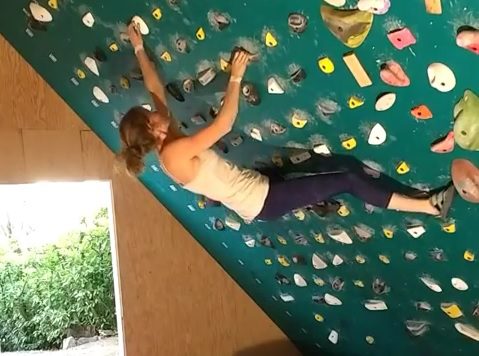Julia Bobak on the MoonBoard: A Core Training Tool

As a climber visiting a climbing website right now, there’s a good chance you’re in tune enough with recent developments to have noticed a sudden proliferation of MoonBoards.
Whether on the Instagram feeds of pro climbers like Daniel Woods and Nina Williams or in the training area of the newest gym, these cool bouldering walls are ubiquitous. So, what is the MoonBoard? Is it a game-changing training method or a passing fad.
The MoonBoard is the brainchild of Ben Moon, a UK-based climber whose resume includes the world’s first 5.14c, V13 boulders and a recent 5.14d ascent at age 48. It is an 8’ × 12’ flat bouldering wall angled 40° and populated with a standardized grid of holds, each in a precise orientation.
The holds are carefully designed to test a user’s full set of abilities – there are pockets, pinches, crimps and slopers. There is, frustratingly, nothing that could be construed as a jug.
Because every MoonBoard worldwide is identical, a problem set by a climber in Korea, or even by Ben Moon himself, can be repeated, graded and commented on by a user in Canada. Want to train like Alex Megos? Find any MoonBoard and you can.
The global nature of the MoonBoard is facilitated by a free app which allows users to test their mettle on established problems, create problems for others to sample, and track their progress. The number of available problems is constantly increasing and is now over 6000, ranging from V4 to V14.
The MoonBoard is designed to train strength and power. The classic problems force the feet to track the hands making powerful dynamic movements, challenging high-steps, and tenuous heel-hooks the name of the game. The holds are small and finger-y in nature with no fewer than three monos in the complete set and some crimps so tiny they challenge the definition of “hand hold.”
The size of the holds coupled with the steep angle make the MoonBoard a relatively advanced training tool much like a campus board. That the app does not allow for problems graded below V4 gives a sense of the target audience. Even experienced climbers must ensure a thorough warm-up before facing the inevitable dynos-to-crimps.
For intermediate and advanced climbers, however, the MoonBoard has proven itself one of the best training tools; particularly when training for outdoor projects. The angle, types of holds, and setting style produces problems that accurately mimic movement on real rock. While competition climbers may not find it the best tool for practicing the technical slab and volume climbing that is currently en vogue, increased finger strength is always beneficial.
Marc-Antoine Vigneault, head-setter and coach at Montreal’s Allez Up gym, and a V12 boulderer, declares it his “favourite training tool for outdoor bouldering” citing the specificity of the training and the reliability of the user-feedback system in yielding accurate grades.
Josh Muller, co-owner of the newly-opened Bolder gym in Calgary, explains his decision to incorporate a MoonBoard into the training area, “We decided to build a MoonBoard because of its unique nature and advanced training qualities. It is a training tool that creates a sense of community around the world.”
Indeed, the MoonBoard is another way for the already tight-knit climbing community to feel even more connected. On a local level, groups of friends with diverse abilities can easily train together, with each climber using the app to find their own challenge.
Globally, climbers can create and share their problems worldwide. As Muller says, “The MoonBoard may be a fad right now with dwindling mainstream popularity in the coming months, but it will always be a great training tool.”


